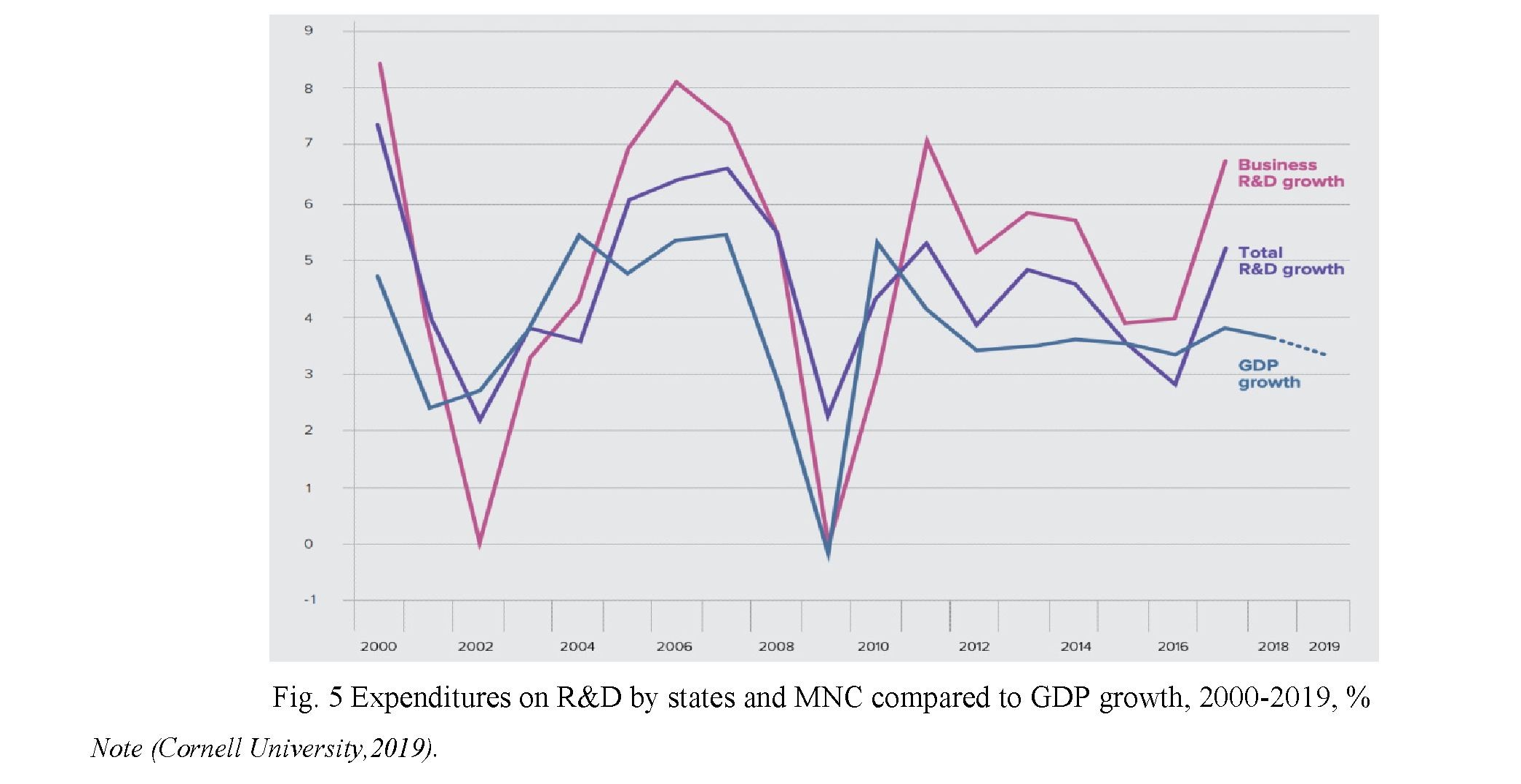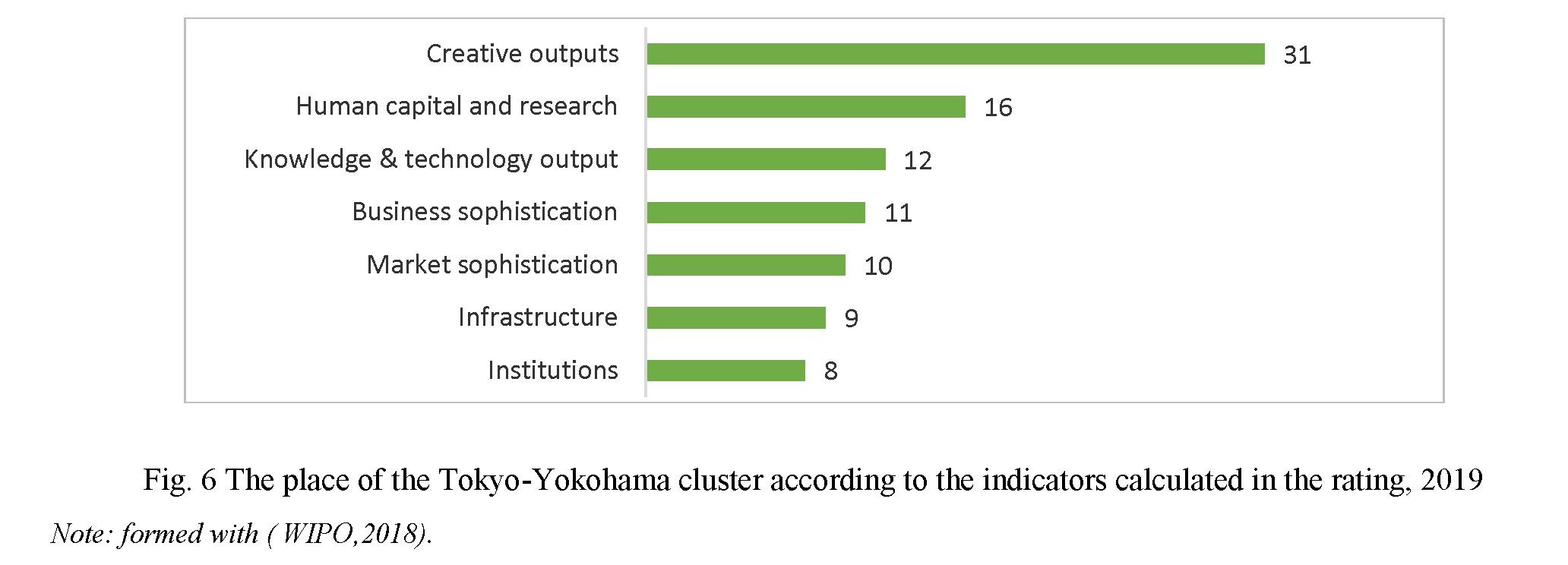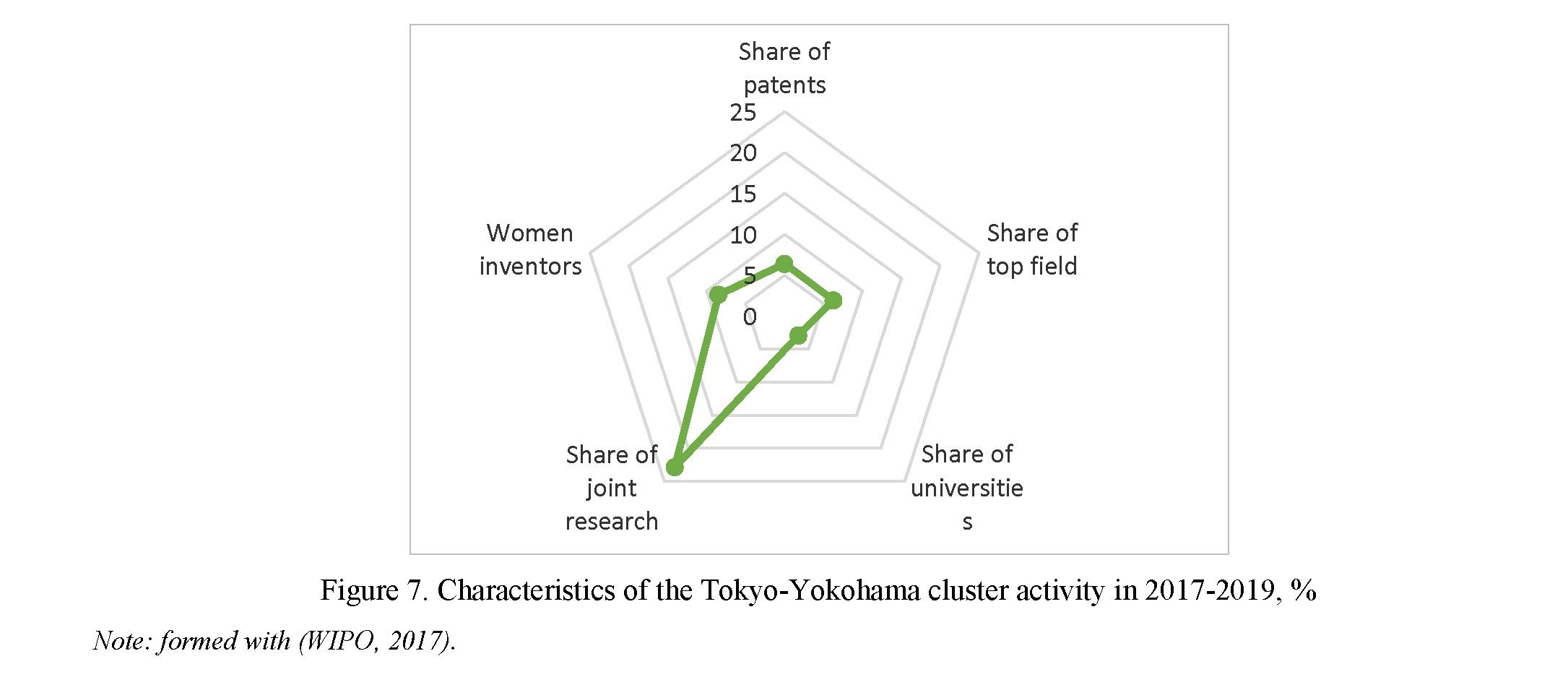Abstract
Object: of the article is to study the current state of cluster development in the world, to identify the most successful examples of cluster functioning, as well as the state of cluster development in Ukraine. Accordingly, the subject of the study were clusters.
Methods: abstract-logical, system-structural analysis, comparative analysis, grouping and graphic methods were used in the article.
Finding: as a result of the study, the state of cluster development in the world was assessed, the best examples of cluster functioning, leading regions and leading countries in this process were identified, and their impact was assessed. The state of cluster development in Ukraine was also taken into account.
Conclusions: thus, the economies which use a cluster approach of doing business were analysed. It was found that the most successful in this process is Japan, which has been leading in various rankings for several years. It was also determined that in Ukraine the cluster method of doing business is currently somewhat underdeveloped compared to other countries, and it is at the initial stage of implementation.
Introduction
The inflow of foreign direct investment is extremely uneven. And if you look at the world map of the location of economic activity, it becomes clear that there is a steady trend regarding the concentration of economic activity of the MNC in certain regions, where such economic entities as clusters are formed. MNCs form clusters for many reasons. Natural advantages can be part of geographical concentration. For example, the location of companies that produce petroleum products and extract coal is probably influenced by the location of fossil fuel reserves (Rogach, 2019). In the modern economy, they are more mature form of economic agglomeration, and geographical proximity was the basis for the formation of clusters at later stages. (Alan, 2003). The main condition for the emergence of clusters are the presence of a large number of enterprises in one territorial region, which are interconnected by joint activities or research base. Accordingly, more and more countries are seeking to introduce this method of economic activity, for the sake of attractiveness to world MNC.
Literature review
A number of scientists have studied this topic. In particular, it should be noted that the greatest contribution to the theoretical work was done by M. Porter, A. Marshall, E. Feser, C., E. Bergman (Bergman, Feser 2004), Ketels (Ketels, 2017). etc. Empirical testing of hypotheses on the functioning of clusters was carried out in the reports of such international organizations as World Intellectual Property, the European Commission, Deloitte, KPMG, etc.
Methods
The following scientific methods were used in the article as an abstract-logical and system-structural analysis - in the study and clarification of the essence of the "cluster"; comparative analysis and grouping - in the study of world best practices of the concept of cluster development; graphic - when constructing graphs and charts.
*Corresponding author.
E-mail address: slozko2003@ukr.net
Results
Clusters arise naturally because there are benefits of co-location affect the growth of firms differently in different locations and increase the attractiveness of specific locations for MNC. The process of cluster formation is shaped both by the decisions that firms make regarding the placement of their investments and the methods of competition, as well as by the decisions of governments and other institutions on the appropriate qualities of the business environment specific to the cluster. Within the location, it is the interaction of evolutionary and constructive forces that contributes to the development of the cluster (The European Observatory for Clusters and Industrial, 2018).
Characteristic features of clusters are:
the presence of a large leading enterprise that combines long-term economic, innovative and other development strategies of the entire system;
- territorial localization of the vast majority of enterprises participating in the cluster system;
- stability of economic relations between the enterprises-participants of the cluster system, the dominant value of these relations for the majority of participants (Legostaeva, 2019).
- socio-cultural proximity of economic agents who form common rules and principles of conduct;
- the presence of intensive vertical and horizontal economic ties, which are based on both market (formal) and non-market (informal) principles of exchange of goods, technologies, services, information and human capital;
- long-term coordination of interaction of participants of the system, within its production programs, innovation processes, basic management systems, quality control, etc.;
- focus of cluster products on export or import substitution;
- availability of modern corporate management systems, control of business processes, collective economic monitoring, etc.;
- a network of public and private local institutions that support cluster members (Boja,2011).
Specialized clusters generate higher growth in the number of higher-paying jobs in eight out of ten industries. They also become placement for MNC, which are constantly expanding their business and the geography of their operations (Baptista, 1998)
Thus, more and more countries around the world are trying to create clusters. The 33 largest clusters in the world according to the World Intellectual Property Organization (WIPO) are located in Asia, 33 - in Europe, 30 - in North America, 3 - in Australia, 1 - in Latin America (fig.1) (WIPO, 2020).
In the context of analyzing the activities of international clusters, as a rule, their activities are concentrated in those industries where the country and its MNC are competitive globally. For example, Israel is cre-

ating technology clusters, Japan is creating innovation clusters, and South Korea is focusing on the creative economy and innovation (European Cluster Collaboration Platform, 2019).
Regionally, Asia has one of the largest numbers of clusters. As for the countries, China is the undisputed leader in 18 clusters, Japan - 3, South Korea - 3, India - 2, the rest of the countries, including Israel, Iran, Singapore, Taiwan, Turkey have one cluster from the WIPO`s rating. (fig. 2) (WIPO, 2020).
In Europe, the situation is somewhat different. There is no such hegemony of one country as in Asia, but there are also leading countries in the number of created clusters included in the WIPO`s ranking. Thus, Germany - 8 clusters, Great Britain - 4, France - 3, Switzerland - 3, Belgium - 2, Spain - 2, Italy - 2, Netherlands - 2, Austria, Ireland, Poland, Russia, Finland and Sweden 1 cluster each (fig. 3) (WIPO, 2020).




In North America, the championship belongs to the United States, where 26 clusters have been created, which makes the country the world leader in creating the last, which is included in the ranking of the largest clusters in the world, then Canada - 4 clusters (fig. 4) (WIPO, 2020).
The development of clusters leads to the strengthening of the overall rating of the country in the context of economic innovation. Thus, in 2019 the most innovative economies of North America were the United States, in Europe - Switzerland, in West Asia - Israel, in Southeast Asia, East Asia and Oceania - Singapore, in Latin America and the Caribbean - Chile, in Africa - South Africa, in Central and South Asia - India.
It also contributes to the development of R&D at both the public and private levels. Thus, global R&D spending grew faster than the global economy and more than doubled between 1996 and 2016. In 2017, global public spending on R&D increased by about 5%, while R&D expenditure on GNP increased by 6.7%, which is the largest increase since 2011 (fig.5) (Cornell University,2019).
However, the largest cluster in the world during 2012-2019 is the Tokyo-Yokohama cluster, or as it is also called "Greater Tokyo". The population of these two cities, which are connected by a powerful cluster, is 44 million people. in 2018, the Cluster ranks second in the world in terms of cooperation with universities included in the QS World Rankings and 60th in the world in terms of the MNC number included in the Fortune 500 ranking companies (Ketels, 2017).
These results have been achieved due to the fact that since the 1980s, Japan has pursued the goal of becoming an economy and a society driven by innovation, science and technology. After the economic and financial crisis that hit Asia in the 1990s, and counter the relocation of production to China and other developing Asian countries, the Japanese government decided to strengthen the competitiveness of the national economy by investing more in R&D and following a cluster approach to strengthening regional ecosystems. The cluster approach was the result of a joint initiative of the Ministry of Economy, Trade and Industry (METI) and the Ministry of Education, Culture and Sports. Such policy has borne benefits and the country's clusters are in the lead (The European Observatory for Clusters and Industrial, 2019).
The rating of the cluster is formed on the basis of 8 indicators that vary from each other. Although "Greater Tokyo" does not occupy a leading position on any of the indicators, but the weighted average of these indicators generally gives the best result (fig.6) ( WIPO,2018).
The largest recipient of the Tokyo-Yokohama cluster is the Japanese MNC Mitsubishi Electric, as the main areas of research are electronics, machinery, equipment and energy. The main university that cooperates with the organization is the University of Tokyo, which conducts joint research in the field of physics. This cluster also cooperates with another cluster, namely Osaka-Kobe-Kyoto (fig. 7) (WIPO, 2017).


As of 2020, there are 36,229,685 people living within the cluster, 313 patents per capita are carried out annually, 397 scientific articles and the total contribution to world research is 0.34%. (WIPO, 2020).
There are also 26 universities and 157 research institutions, with a total of 141,350 researchers working with about 8,250 MNCs. (LIP, 2020).
Discussions
Unfortunately, in Ukraine the cluster form of doing business is not as developed as in other countries. Moreover, statistical cluster accounting has not been introduced in Ukraine so far. There is also no official data on clusters (Borzenko, 2017)
As of 2018, more than 60 cluster entities of various scales are currently functioning and identifying themselves as clusters in the Internet space in the regions of Ukraine. They are created mainly as public organizations and public unions, less often - as societies, corporations, associations or utilities.
Most clusters are in Zaporizhia region , Lviv region , Kharkiv region, in others - from 1 to 4, only in Zhytomyr and Luhansk regions there is no cluster yet.
The vast majority of clusters have been established within the last two to three years, and many of the clusters identified earlier (from the 1990s to 2010) are no longer operational. The initiators of the clusters were mostly business representatives. Although, the clusters were supported by the authorities, some higher education institutions are currently showing cluster initiatives, in particular in Kirovohrad, Kharkiv, and Kherson regions, which provides them with scientific and methodological support. - Many cluster projects are implemented by international organizations, especially today, in the context of decentralization.
Most of the clusters registered in Ukraine are agricultural, but creative ones are gradually emerging.
In the village. Hrytsiv, Khmelnytsky region, a cluster of rural green tourism "Oberig" was created this year. It unites 10 agro-villages that receive tourists who want to relax in the village.
In Poltava region there is a cluster project for producers of ecological products. It focuses on the inspection and control of the production of organic products. Those productions that have passed the inspection are issued a special certificate. It confirms the quality of the implemented eco-technologies.
The Ukrainian-Romanian "First Agrarian Cluster" was created in Chernivtsi region. It combines producers of fruit and berry products and horticultural development. The task of the cluster is to support entrepreneurs at all stages from cultivation to implementation: to maintain interaction between producers and inspectors, transporters and consumers. The work of the cluster is also to improve the investment climate, to negotiate with local governments, to create conditions for the training of necessary specialists.
A regional agro-industrial innovation cluster "Agroinnovation" has been created in Rivne. The cluster focuses on the development and implementation of innovations in the agro-industry of the region. There is also another cluster in Rivne - "Naturalne Moloko". It was founded by agricultural enterprises of Rivne, Ternopil and Lviv regions, working in the field of dairy farming. The cluster serves primarily as a defender of the interests of industries and supports their interaction.
In Vinnytsia region, a food processing cluster has been established within the framework of the EU Sustainable Regional Development Project (SSRD). It helps to unite farmers in cooperatives, to establish partnerships between producers and processors of agricultural products.
The most powerful IT cluster in Ukraine, which includes 65 companies, operates in Lviv. Today IT Park is being built in Lviv - a quarter with 6 office buildings, 2 business centers, a hotel, a shopping center, a university, a kindergarten, the size of 10 hectares (Business associations, 2019).
It is also worth noting the existence of two international clusters in Ukraine. Thus, in the city of Kakhovka, Kherson region. Since 2012, the international, interregional, agro-industrial cluster "Eastern Food Technologies plus" ("Ea.F.Tech +") has been operating. The cluster is aimed at mutually beneficial cooperation in the implementation of a specific commercial project.
"Ea.F.Tech +" - works on the principle of "technological chain", in order to unite the efforts of participants and partners of the cluster, in the framework of project support, in the field of cultivation, collection, storage, pre-sale preparation, processing and sale food, by combining commercial offers from the best players in the market into a single agreed commercial package.
The cluster unites more than twenty commercial companies from Ukraine, Italy, Russia, Lithuania (the process of forming the members of the cluster "Ea.F.Tech +" continues).
The total annual turnover of the cluster member companies is approaching 100,000,000 US dollars, and the cluster member companies employ about 2,000 people.
On March 19, 2018, the Ea.F.Tech + Cluster became a member of the European Cluster Cooperation Platform. (European Cluster Cooperation Platform established by the European Commission under the SME Cluster Internationalization Program, funded by the European Union's COSME program launched by DG GROW in 2016.
Another international cluster in Ukraine is the Association of Automation Industry of Ukraine, which was established in 2011. The mission of the Association is to develop the local market by setting professional standards in the technical field and business development. It represents the interests of the Ukrainian industrial automation community.
The Association functions as a non-governmental and non-profit organization uniting legal entities. The budget of the Association is formed from membership fees, grants and sponsorship fees.
In 2016, the Association created the national movement "Industry 4.0 in Ukraine", which today has more than 80 members.
The mission of the movement is to promote and educate the local market on 4.0 technologies (IoT, artificial intelligence, robotics, etc.).
The Association also works closely with the government in developing innovation, export and industrial policies in Ukraine. In 2016, the Association was a member of the pro-government Digital Agenda Ukraine program, where it developed an initiative for Smart Factory / Industry 4.0 (Business associations, 2019).
Conclusions
Thus, clusters play a significant role in the development of individual cities and attract a significant part of MNC to conduct its economic activities within such groups, as most scientific discoveries, patents, scientific articles and research are made within clusters, which allows individual companies to be global innovators in their niches. Ukraine, as well as a number of other countries, is characterized by increasing the degree of urbanization and overcoming this challenge. However, currently in Ukraine the development of the cluster economy and the creation of clusters is only gaining momentum and does not have such a strong impact on the general welfare of the state as in a number of other countries. However, some cases of implementation of the cluster approach in the economy deserve attention.
References
- Baptista R. (1998). Do firms in clusters innovate more? Retrieved from https://www.sciencedirect.com/science/article/abs/pii/S0048733398000651
- Bergman E., Feser E. (2004). Industrial and Regional Clusters: Concepts and Comparative Applications. Retrieved from http://www.rri.wvu.edu/WebBook/ Bergman-Feser/contenst.htm
- Biznes-asociacija «Pro klastery v Ukraini» (2019). [Business associations «About clusters in Ukraine»]. business100.ks.ua Retrieved from http://business100.ks.ua/pro-klasteri-v-ukrayini-ta-sviti/(in Ukraine ).
- Borzenko O.O. (2017). Innovacijne ekonomichne zrostannja jak element suchasnogo reguljuvannja ekonomikoju [Innovative economic growth as an element of modern economic regulation]. Problems of attracting foreign investment in the country's economy: materialy kruglogo stolu (m. Kyi'v, 20 lystopada 2017 r.) - proceedings of the meeting. (pp 34-36.) – Kyiv: NUHT. (in Ukraine ).
- Catalin Boja. (2011). Clusters Models, Factors and Characteristics. Retrieved from http://sintonia.mx/mm/cmfc.pdf Cornell University (2019). The Global Innovation Index 2019: Creating Healthy Lives—The Future of Medical Innovation. Retrieved from https://www.fguell.com/blog/wp-content/uploads/2020/08/wipo_pub_gii_2019.pdf
- European Cluster Collaboration Platform. (2019). Report: Cluster programmes in Europe and beyond. Retrieved from https://www.clustercollaboration.eu/news/report-cluster-programmes-europe-and-beyond
- Ketels K. (2017). Cluster Mapping as a Tool for Development. Retrieved from https://www.hbs.edu/faculty/Publication%20Files/Cluster%20Mapping%20as%20a%20Tool%20for%20Developme nt%20_%20report_ISC%20WP%20version%2010-10-17_c46d2cf1-41ed-43c0-bfd8-932957a4ceda.pdf
- Legostaeva A. (2019). Nekotorie aspekti tsifrovoiy transformatsii biznes modeley sistemi zdravoohraneniya. [Some aspects of digital transformation of business models of health care system]. www.keu.kz. Retrieved from https://www.keu.kz/attachments/article [in Russian]..
- LIP (2020). Life Innovation Promotion Division Economic Affairs Bureau City of Yokohama. Retrieved from https://businessyokohama.com/wp-content/uploads/2020/03/LIP_Yokohama_Brochure.pdf
- OECD (2020). Metropolian areas. Retrieved from https://stats.oecd.org/Index.aspx?DataSetCode=CITIES
- Oficialnyj veb-sajt «Asociacija pidpryjemstv promyslovoi avtomatyzacii Ukrainy» (2020). [Official website «Association of industrial automation enterprises of Ukraine»]. appau.org.ua Retrieved from https://appau.org.ua/(in Ukraine ).
- Rogach O. (2019). MNC`s Theory and Global Value Chain. Retrieved from https://www.researchgate.net/publication/334994987_MNE's_THEORY_AND_GLOBAL_VALUE_CHAINS
- Rugman Alan M. (2003). Multinational Multinational Enterprises and Clusters: An Organizing Frameworktional Trade. Retrieved from https://www.researchgate.net/publication/200465313_Multinational_Enterprises_and_Clusters_An_Organizing_Fra mework
- The European Observatory for Clusters and Industrial (2018). Transformation Trends Report. Retrieved from https://ec.europa.eu/growth/industry/policy/cluster/observatory_en
- The European Observatory for Clusters and Industrial (2019). Trends in European clusters: results from the 2019 European panorama, trends and priority sectors reports published. Retrieved from https://ec.europa.eu/growth/content/trends-european-clusters-results-2019-european-panorama-trends-and-priority- sectors-reports_en
- WIPO (2017). The World`s Top 10 Innovation Hotspots. Retrieved from https://www.wipo.int/econ_stat/en/economics/news/2017/news_0005.html
- WIPO (2018). Global Innovation Index. Retrieved from https://www.wipo.int/edocs/pubdocs/en/wipo_pub_gii_2018- profile23.pdf
- WIPO (2020). The Global Innovation Index (GII) 2020. Retrieved from https://www.globalinnovationindex.org/Home